|
||
melhor visualizado em
1024 x 768 |
|
|
|
||
melhor visualizado em
1024 x 768 |
|
|
| WW2 - Brazilian Expeditionary Force (FEB) |
1st DIE - Expeditionary Infantry
Division ( Divisão de Infantaria Expedicionária) |
||
"The snake is going to
smoke" |
||
|
 |
It was not at all obvious that Brazil would join the Allied powers in World War II. Initially Brazil maintained neutrality, trading with both the Allies and the Axis, while Brazilian president Getúlio Vargas's quasi-Fascist policies indicated a leaning towards the Axis powers. Vargas had a strong inclination for the totalitarian European dictatorships; his chief of staff openly sympathized with the German government, as well as many leading personalities of the country’s political life. |
Brazillians, note the american style equipment. |
BRAZIL DECLARE WAR !! During the negotiations between Americans and Brazilians, Vargas managed to gain technical advice from the U.S. to build the Volta Redonda steel mill. Even before the declaration of war on Germany, Brazil had been sending raw materials to Allied nations. Still, Brazil permitted the US to set up air bases in the states of Bahia, Pernambuco and Rio Grande do Norte(RN). Ultimately, increasing trade with and diplomatic efforts by the United States and Britain, combined with the sinking of several Brazilian merchant vessels by German and Italian U-Boats, moved public opinion to force a declaration of war against the Axis on August 22nd, 1942. |
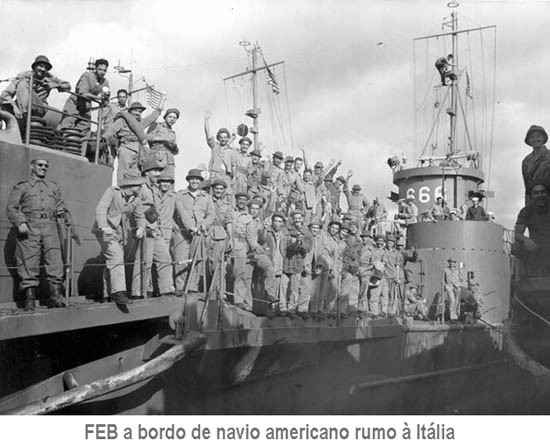 |
|
The Northeastern coast of Brazil was considered the weakest point of a possible invasion of the Americas, which by 1941, with the Axis’ successful campaign in North Africa (Afrikan Korps), was justly feared. After summits between Roosevelt and Vargas’ representatives, they both agreed on limited cooperation, and this would include permission for the Americans to establish a massive air base complex in the Northern city of Natal-RN, which would become known as the "Springboard of Victory", bringing constant supplies to the troops in North Africa, and with the Brazilian Army maintaining coastal defenses in the area. Soon German and Italian reprisals would be heard of. From 1941 to 1943, 32 Brazilian vessels fell victim of U-boats all along the coast, with painful consequences to the national spirit, which eventually led to the declaration of war on Germany and Italy in August 1942, a bold decision for a country such as Brazil, when the outcome of the war was far from predictable. Patrolling was also a task of the Navy, and a part of the fleet escorted convoys along the Atlantic. By 1943, the outmost post occupied by Brazilians was the paradisiacal but unfamiliar island of Fernando de Noronha, 100 km off the coast of Pernambuco. |
Patrolling the brazilian coast |
|
Parade in Rio de Janeiro 1944 |
THE WOMAN IN THE BARRACKS
Though all the moments that was present in activities of the Earth Force the Brazilian woman has always shown her great value. Since Maria Quitéria, passing through the nurses that worked in the Second World War until the officers of the Quadro Complementar de Oficiais, the female segment has given valuable contributions to the Brazilian Army. Apart from all of these mentioned things, women have also conquered their space at the Military School, at the Instituto Militar de Engenharia and in the Volunteer Military Service. For sure, the Army's lines nowadays are more strengthened with the female presence in the barracks. |
AFRICA OR EUROPE ? There were a series of setbacks concerning the early stages of the FEB organization, especially regarding its training stages. It had been previously combined that the 1st Expeditionary Infantry Division (1st DIE, for Divisão de Infantaria Expedicionária), was to be sent to a theater of operations presenting the closest similarity possible to Brazilian climatic conditions. By the time of its birth, the obvious front to send the FEB was North Africa, but the Allies ability to end the war in that theater seemed to top Brazilian enthusiasm. As a result, Gen. Mascarenhas visited the Italian battle fronts early in 1944, since that at least during summer time Italy’s climate would not be so hard to withstand for men accustomed to very hot weather, as it was thought by high ranking Brazilian officers. How wrong they were. |
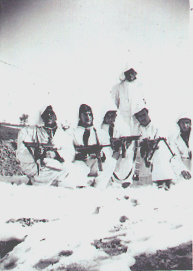 |
THE COMMAND The Brazilian 1st Division of the FEB was under the command of 15th Army Group of Field Marshal Harold Alexander (later General Mark Clark), via the US Fifth Army of Lieutenant General Mark Clark (later Lieutenant General Lucian Truscott) and the US IV Corps of Major General Crittenberger. The Brazilian Air Force component was under the command of XXII Tactical Air Command, which was itself under the Mediterranean Allied Tactical Air Force. |
General Mascarenhas de Moraes |
|
The FEB headquarters functioned as an administrative headquarters and link to the Brazilian high command of Generals Eurico Gaspar Dutra, Mascarenhas de Moraes, Zenbio da Costa and Cordeiro de Farias. The FEB was organized as a standard American infantry division, complete in all aspects, down to its logistical tail, including postal and banking services. It comprised the 1st, 6th and 11th Infantry Regiments of the Brazilian Army. Each regiment had three battalions, each of four companies. THE CAMPAIGN Soon after Brazil declared war it began the mobilization to create an Expeditionary Force to fight in Europe. This was a giant US-sponsored effort to convert an obsolete army into a modern fighting force. It took two years to properly train the 25,300 troops to join the Allied war effort. In early July 1944, the first five thousand FEB soldiers left Brazil to Europe aboard the USNS General Mann, and disembarked in Naples, where they waited for the US Task Force 45, which they later joined. On late July, two more transports with Brazilian troops reached Italy, with two more following in November and February 1945. |
"Two commanders" |
|
reconnaissance operations with M-8 Greyhound |
The first weeks of the Brazilians in Italy were dedicated to acquiring and training with the new American uniforms, since the Brazilian ones would not suit the Italian climate. The troops moved to Tarquinia, 350km north of Naples, where Clark's army was based. The FEB was later integrated into General Crittenberger's IV Corps. The first missions of the Brazilians involved reconnaissance operations. The Brazilian troops helped to fill the gap left by several divisions of the Fifth Army and French Expeditionary Force that left Italy for the invasion of southern France. On November 16, the FEB occupied Massarosa. Two days later it also occupied Camaiore and other small towns on the way north. |
By then the FEB had already conquered Monte Prano, controlled the Serchio valley and the region of Castelnuovo, without any major casualties. The Brazilian soldiers, after that, were directed to the base of the Apennines, where they would spend the next months, facing the harsh winter and the resistance of the Bernhard and Gustav lines.
It was in that region that the Brazilian soldiers, together with men of many other nationalities, made one of their main contributions to the war: the Battle of Monte Castello. The combined forces of the FEB and the American 10th Mountain Division were assigned the task of clearing Monte Belvedere of Germans and minefields. The Brazilians suffered from ambushes, machine gun nests, and heavy barrages of mortar fire.
|
FEB in Monte Castello |
On late February, while the battle for Monte Castello was still taking place, parts of the FEB conquered the city of Castelnuovo and, on March 5, Montese. The German mass retreat had started. In just a few days, Parma and Bologna were taken. After that, the main concern of the Allied forces in Italy was pursuing the enemy. After capturing a large number of Germans on Collechio, the Brazilian forces were preparing to face fierce resistance at the Taro region from what was left of the retreating German army. The German troops were surrounded near Fornovo and forced to surrender. More than sixteen thousand men, including the entire 148th Wehrmacht Infantry Division, parts of the 80th Panzer division, several Italian units and more than a thousand vehicles, surrendered to the Brazilian Forces on April 28. |
On May 2, the Brazilians reached Turin and met French troops at the border. Meanwhile, on the Alps, the FEB was on the heels of German forces still on the run. On that very day, the astounding news that Hitler was dead put an end to the fighting in Italy. All German troops finally surrendered to the Allies in the following hours.
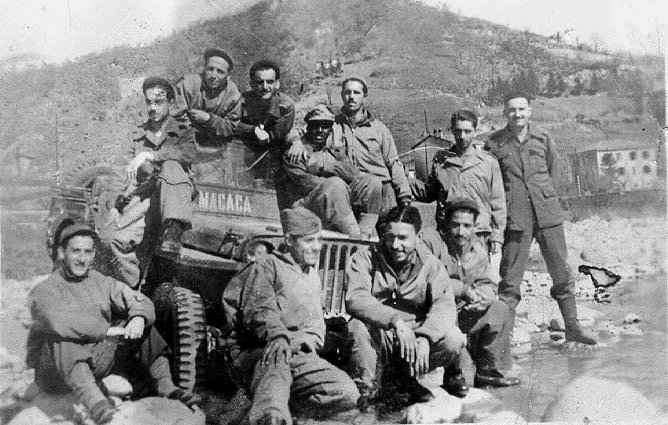 |
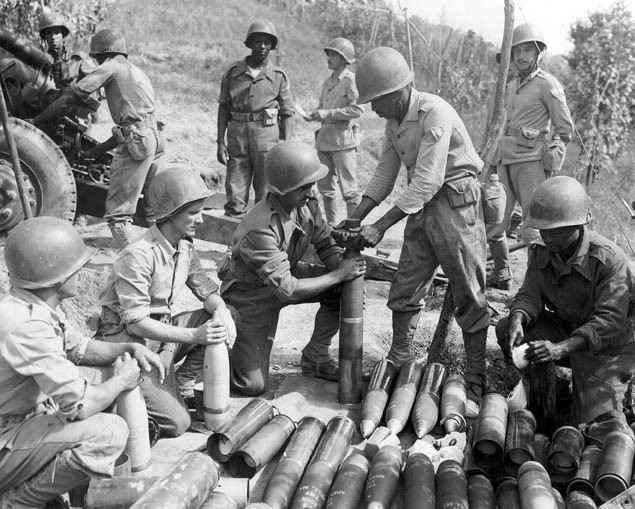 |
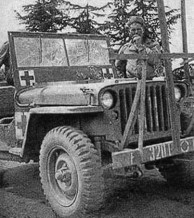 |
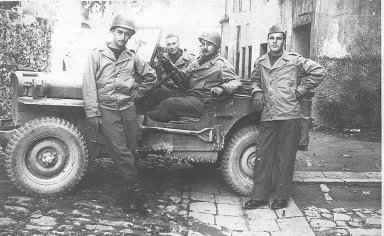 |
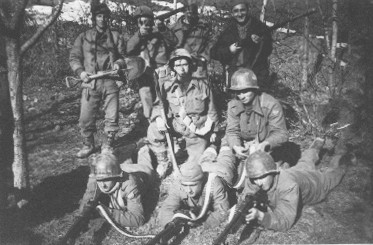 |
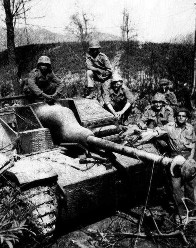 |
|
FEB liberate Massarossa |
THE OUTCOME
Generally, the men of the 1st DIE aquitted themselves well, gaining the trust of Italian civilians and combat experience in unfamiliar terrain, though at some cost. They were proud to represent their country and proud of their divisional patch, a snake smoking a cigar (said to stem from a reaction to German comments that the day Brazilians joined the fighting, snakes would smoke). The Division was hampered by an officer corps that was not used to working with and sharing the same conditions as the rank and file. Units of the 1st DIE in the late war period are therefore rated Confident Trained. It is worth noting that the Brazilian rank and file drew on men from many ethnic backgrounds and, unlike the US army at this time, was not segregated. |
They had lost 480 men killed, 2064 wounded and 34 MIAs. On the other hand, the FEB captured 20, 573 prisoners prior to the end of the war.
Moreover, the Brazilian soldiers fighting in Europe faced an ironic dilemma: "How can we be fighting for Democracy if we don’t have it back home?" When the troops returned to Brazil, Vargas was finally overthrown and Brazil conquered the democracy again.
 About
"1st Brazilian Fighter Squadron" in WW2
About
"1st Brazilian Fighter Squadron" in WW2
AFTER WAR
On 1964, Brazil was facing a state takeover arquitetured by the army, by the financial elite and by the US government, their old ally in WW2. Based on the doctrine of national secutiry and development, the military stabilished a brazilian dictatorship which lasted two decades.
Links:
http://www.nationmaster.com/encyclopedia/Brazilian-Expeditionary-Force
http://www.5tharmy.army.mil/
Brazil and World War II: The Forgotten Ally.- http://www.tau.ac.il/eial/VI_2/mccann.htm
http://www.generals.dk/nation/Brazil.htm
http://www.brazzil.com/pages/p125apr03.htm
http://www.jaymemonjardim.com/_english/aquarela/guerra/conteudo.htm
http://www.brasilmergulho.com/port/naufragios/u-boats/artigos/2002/001.shtml
http://www.rudnei.cunha.nom.br/FAB/br/patrulha.html
http://planeta.terra.com.br/educacao/inventabrasil/democrt.htm